Concentrate on just 4 CX metrics and you’ll see greater progress in more than 20 growth metrics. Precedents for this approach include fitness, student performance, and most things in life.
- For example, in fitness, instead of miracle pills or constant weighing or Spanx®, it’s best to focus on calories eaten, calories burned, and mindset/stress management. By focusing on the root causes, your success is far greater.
- And for student performance, instead of getting exam answer keys or flattering the instructors, it’s best to focus on listening, note-taking, homework, and reviewing. Get the fundamentals right, and enjoy the positive domino-effect of your good habits.
Likewise, for financial growth from customer experience (CX), it’s best to focus on these 4 CX metrics:
- CX-inspired growth
- CX-inspired performance
- CX-inspired strategies
- CX-inspired efficiencies
These 4 metrics synchronize your value proposition and what customers get. Otherwise, gaps between these will cost you a lot (negative word of mouth (customer effort score, CSAT), churn, costs to serve, internal productivity, etc.). It’s basic: say what they’ll get and deliver that exactly.
This basic rule is true for every human relationship. As changes happen, communicate proactively to manage expectations. To deliver what’s promised, coordinate companywide, with the aim of continually increasing value for everyone.
This article is a continuation of 24 CX ROI Metrics for Your Chief Customer Officer Prosperity Playbook. There you can see the equations for 24 customer experience metrics expressed in money rather than percent or scores, making financial gains obvious.
Let’s explore the 4 gold metrics that drive every CX metric.
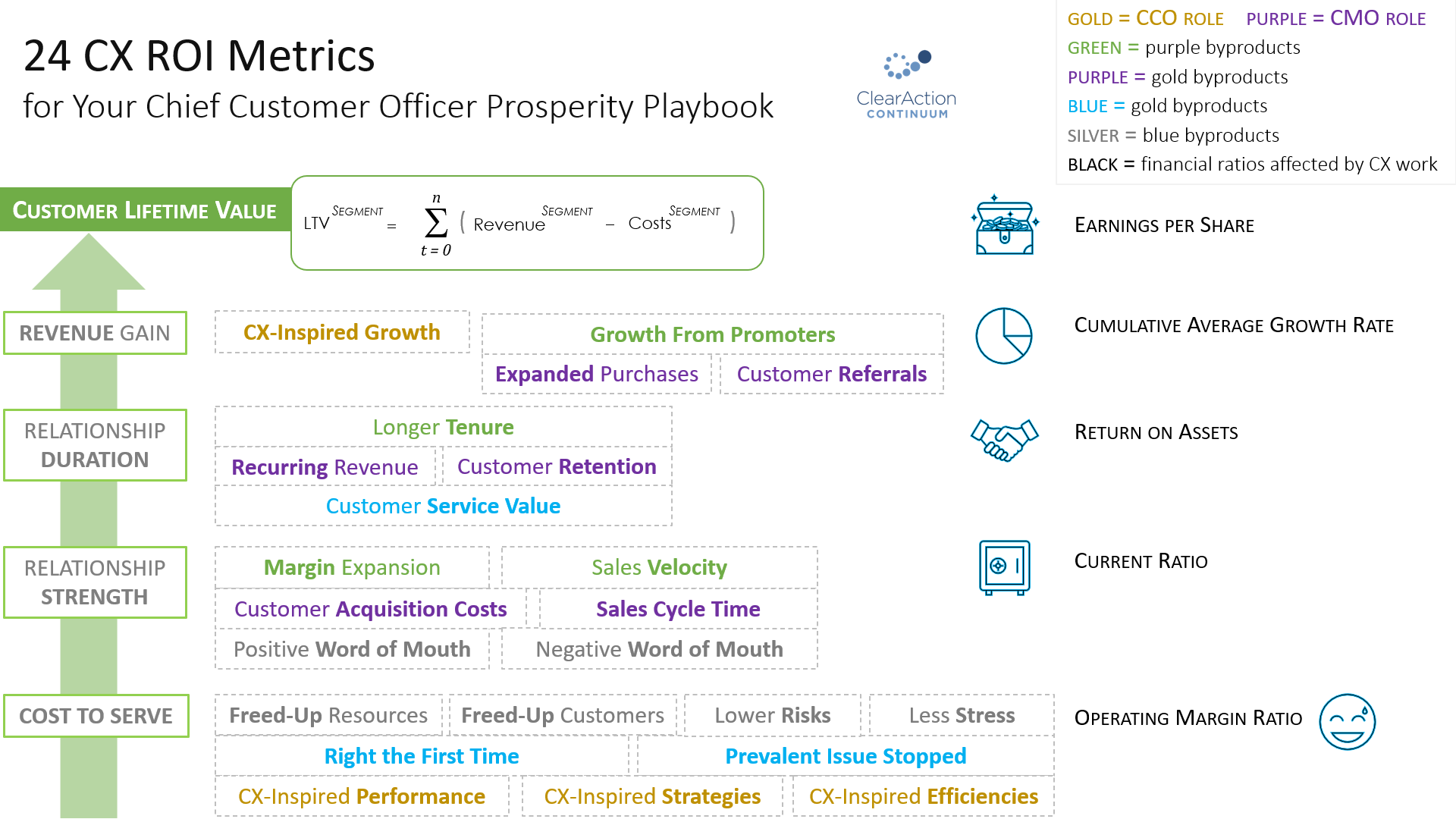
CX-Inspired Growth
We all know the value of human-centered design:
- Start with a deep understanding of users’ situations before you begin creating something.
- Adapt quickly from user feedback frequently during development of your plan.
- Adapt quickly from ongoing feedback loops after you launch it.
With customer-alignment at the origin of designs, launches are much more successful.
Is this approach used for every growth effort in your firm?
- Apply this to every product upgrade, new product, new market, new business model (pricing, warranty, financing, discount policy, etc.), alliance, and merger.
Why should any of these growth efforts avoid human-centered design principles? Does it cost you whenever human-centered design is missing?
Your influence: You’re collecting customer experience insights every moment in databases of all kinds. When you data mine CX insights and inspire managers to use it for every growth effort, you’ll see much higher performance in these growth metrics:
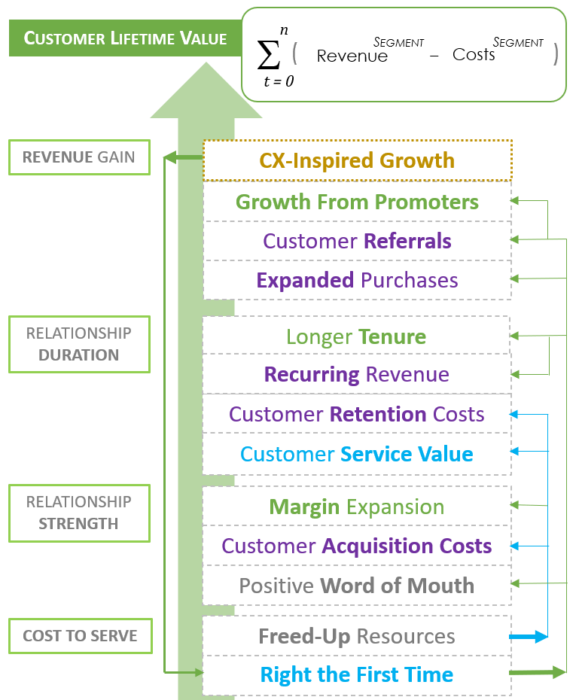 CX-Inspired Growth leads to Right the First Time.
CX-Inspired Growth leads to Right the First Time.
- Right the First Time leads to Freed-up Resources, which reduces Customer Acquisition Costs, Customer Service Value costs, and Customer Retention costs (Customer Health Score), which lead to Margin Expansion.
- Right the First Time leads to Positive Word of Mouth (NPS) and Customer Referrals, which contribute to Growth from Promoters.
- Right the First Time leads to Longer Tenure, Recurring Revenue, and Expanded Purchases, which is Growth from Promoters and other customers.
- All of this grows Customer Lifetime Value.
CX-Inspired Performance
Whenever a new executive oversees you, your radar picks up what he/she likes and doesn’t like, and you make adjustments accordingly. Otherwise, you’ll waste a lot of opportunities and energy — and risk your job.
Ultimately, your salary, budget, and profit-sharing are provided by customers. They’re the hand that feeds you — your true boss. Whenever something bothers customers, it costs your company, and that reduces what’s available for salaries, budgets, and profit sharing.
Therefore, it’s plain sensibility for every employee and executive to absorb what customers like and don’t like, and translate that to their thinking, decisions, actions, and handoffs.
Is this approach used for performance of every department in your firm?
- Share customer insights with every department.
- Help them apply CX insights to their thinking, decision, actions, and handoffs.
Why should any department act in a silo from the hand that feeds them? Does it cost you when a department is out of sync?
Your influence: Use each department’s lingo to share customer experience insights with them on a regular basis. (No need to teach them how to interpret your lingo, scales, etc. — just show them what the insights mean for their work!) When you emphasize data patterns and customer comments to show every employee the CX context for their job’s purpose, you’ll see much higher performance in these growth metrics:
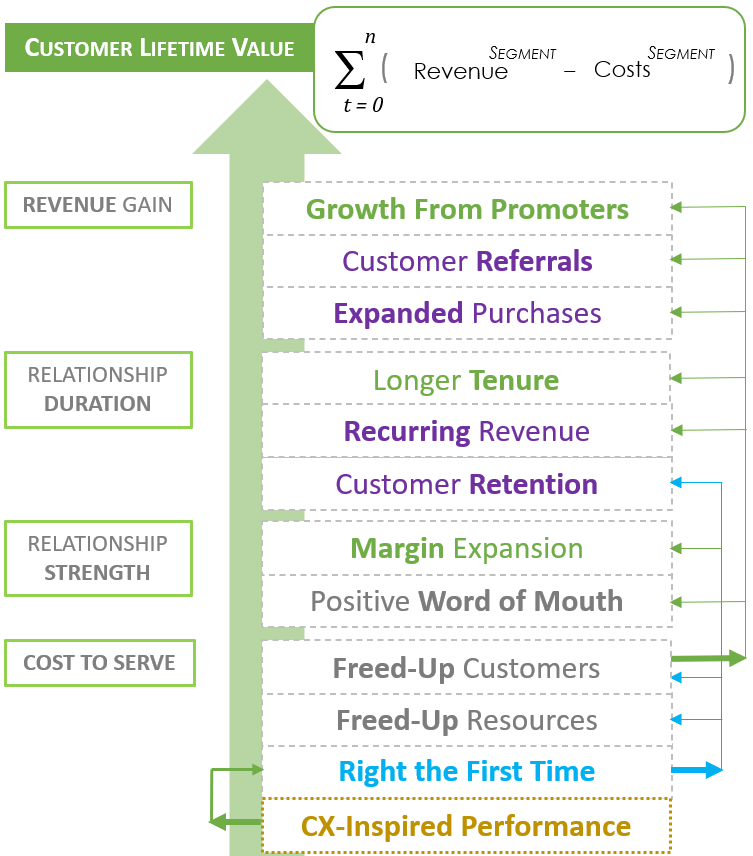 CX-Inspired Performance leads to Right the First Time.
CX-Inspired Performance leads to Right the First Time.
- Right the First Time leads to Freed-up Resources, Freed-up Customers, and Lower Customer Retention Costs (Customer Health Score).
- Freed-up Customers leads to Positive Word of Mouth (NPS) and Customer Referrals, along with Margin Expansion, Recurring Revenue, Longer Tenure, and Expanded Purchases, which is Growth from Promoters and other customers.
- All of this grows Customer Lifetime Value.
CX-Inspired Strategies
Investors expect to be rewarded by continually higher revenue from customers with impressive earnings per share. Both revenue and earnings depend on aligning to customers as well as ̵ or better than ̵ your competitors do.
Investors and competitors are the cart; customers are the horse that take you to your destination. Whenever you put the cart before the horse, you limit yourself. Put the horse in front of the cart by using CX insights as every departments’ North Star.
When I led companywide customer experience transformation, we conducted our annual customer relationship survey with the findings available 3-4 months before strategic planning began. Then, my team facilitated survey readouts and action plan workshops with every line of business, account team, and support function.
When everyone received their strategic planning instructions, guess what was top of mind for them? Yes, they started their SWOT analysis with customers’ views, and then they added their expertise to that.
It’s extremely powerful to align every department companywide on a crystal clear view of customers’ aims and customer experience gaps. This puts the horse before the cart, to quicken your pace in market share gains and lifetime value.
Is this approach used for every strategy in your firm?
- Align customers’ end-to-end journey and your value proposition.
- Then align the non-customer-facing value-chain to drive a 1-to-1 ratio between what’s promised and delivered.
- Assign your CX Council to smoothing silos.
- Connect every financial outcome to customer outcomes.
Why should any strategy be out of sync with customers’ well-being? Does it cost you when a strategy is not based on customers’ views?
Your influence: You’re creating customer personas to guide touchpoint excellence. You can discover the overall 2-4 themes across personas that answer: what are their biggest showstoppers and why? When you focus everyone on 2-4 overall themes, this makes it simple for them to align their strategies and tactics with customers. Then, you’ll see much higher performance in these growth metrics:
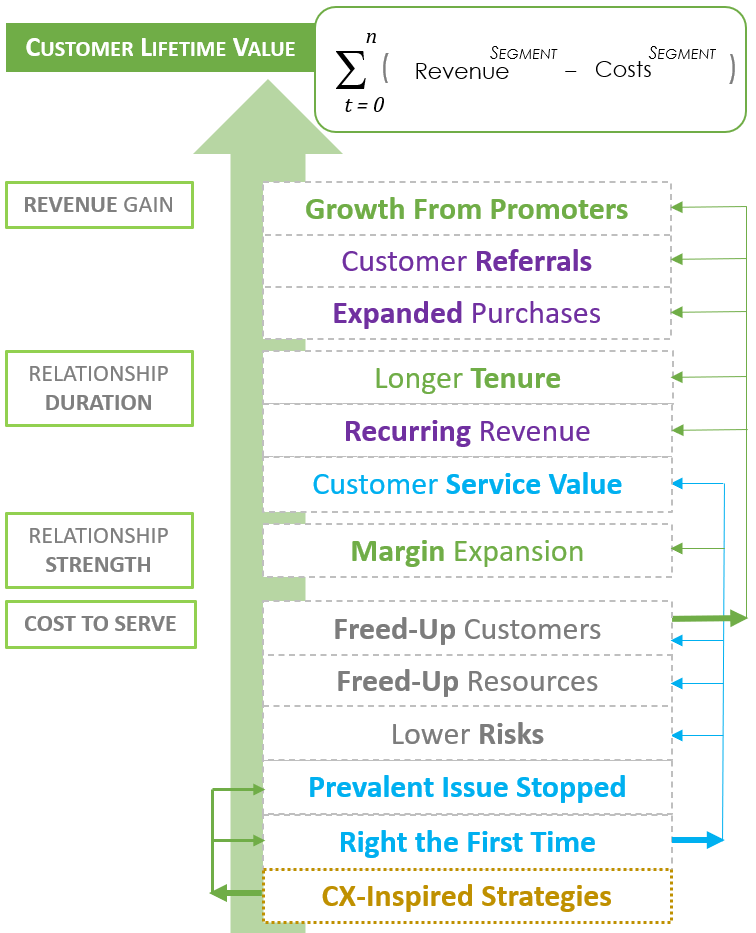 CX-Inspired Strategies lead to Right the First Time and Prevalent Issue Stopped.
CX-Inspired Strategies lead to Right the First Time and Prevalent Issue Stopped.
- Right the First Time leads to Lower Risks, Freed-up Resources, Freed-up Customers, and lower Customer Service Value costs, which leads to Margin Expansion.
- Freed-up Customers leads to Recurring Revenue, Longer Tenure, Expanded Purchases, Customer Referrals, which is Growth from Promoters and other customers.
- All of this grows Customer Lifetime Value.
CX-Inspired Efficiencies
“Do more with less” is a constant challenge, but you can increase value while you make processes, policies, teams, and resourcing more efficient. How? Pay attention to what bothers customers as your guideline throughout efficiency efforts. Combine that with what customers are aiming for in their pursuits with your firm, and use your creativity to add-in higher value as you cut out low value.
Think about it like this:
- Are investors receiving less than they did pre-pandemic?
- Are employees’ work spaces and salaries lower than pre-pandemic?
- Are customers getting less and paying more than they did pre-pandemic?
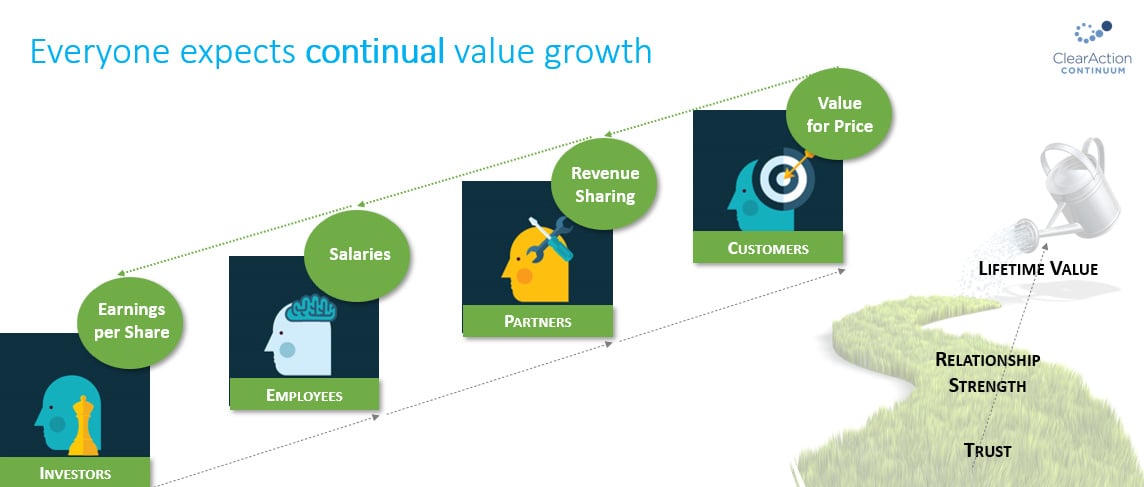
In most industries, customers are the only losing party. This does not add-up! You rely on customers’ funding for your salaries, budgets, and profit-sharing. Customers’ prosperity is your path to prosperity.
When I led companywide CX, we engaged every line of business, account team, and support function in stopping recurrence of 2 prevalent issues to which they were contributing. Therefore, we had 100+ action plans simultaneously every year.
This saved customers millions in hours and money. It reduced stress and increased trust. Our customer relationships were strengthened, with greater immunity from competitors’ offers. Customers’ prosperity was our path to much higher revenue, margin expansion, sales velocity, and lifetime value gains.
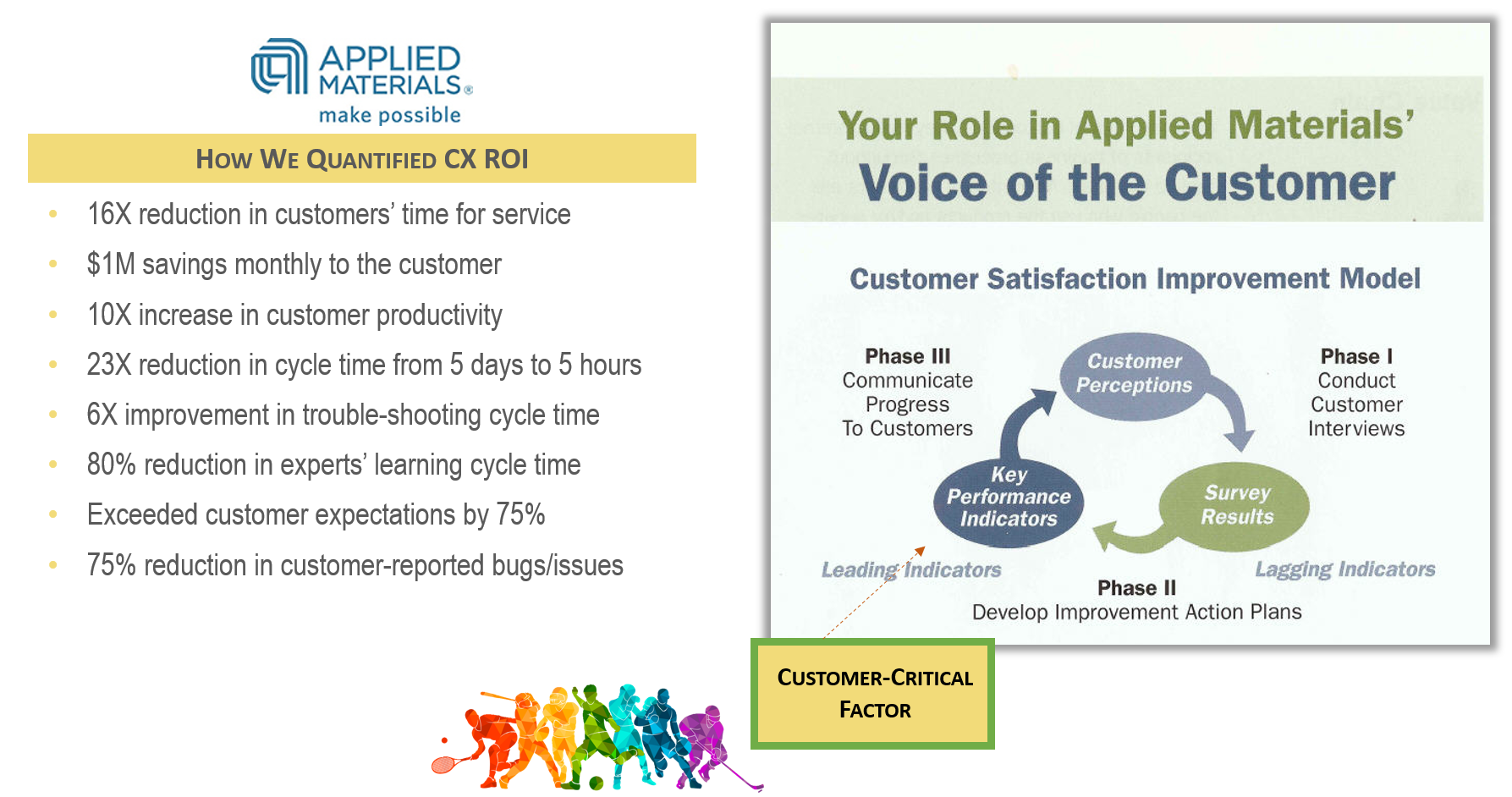
Is this approach used for every efficiency effort in your firm?
- Apply this to every process improvement, policy revision, restructuring, and budget revision.
Why should any of these efficiency efforts ignore what customers value? Does it cost you when you reduce value to customers?
Your influence: Your team is on a hamster wheel of resolving issues thrown over the fence to Customer Service and Customer Success. When you engage every group in doing their part to stop waste from customers’ viewpoint, you’ll see much higher performance in these growth metrics:
 CX-Inspired Efficiencies leads to Prevalent Issue Stopped, Less Workplaces Stress, and Lower Risks.
CX-Inspired Efficiencies leads to Prevalent Issue Stopped, Less Workplaces Stress, and Lower Risks.
- Prevalent Issue Stopped leads to Freed-up Resources, Less Workplace Stress, and Lower Risks, which reduce Customer Service Value costs and Lower Retention Costs (Customer Health Score).
- Prevalent Issue Stopped leads to Freed-up Customers, which leads to less Negative Word of Mouth (customer effort score, CSAT), which leads to shorter Sales Cycle Time and higher Sales Velocity.
- Freed-up Customers also leads to Margin Expansion and Expanded Purchases among Promoters and other customers.
- All of this grows Customer Lifetime Value.
Focus on 4 CX ROI Metrics
No matter how big your team is, you will always be on a hamster wheel of resolving issues thrown over the fence to Customer Service and Customer Success (CS). This includes revenue pressure to make up for high costs to serve customers whose experience didn’t match your value proposition. Revenue pressure increases as more budget is needed in Marketing and Sales to make up for churn and negative word of mouth, and as more budget is used for CS technologies.
Everyone wants precious budget to increase growth opportunities, rather than using it to make up for mis-steps. The best way to get off the hamster wheel is to prevent mis-steps in the first place.

The best gift your CX team can give your company (executives, employees, partners, and investors) is prevention of mis-steps. Nobody knows what a mis-step is until you educate them through CX insights. Managers are unaware of the CS burdens they’re contributing to unless your CX team tells them. Everyone is doing the best they can, with horse-before-the-cart vision, until your CX team shows them a simple way to make customers’ prosperity the North Star for every decision and handoff companywide.
Your CX team’s success begins with the ways you collect, clarify, communicate, and champion CX insights (4 C’s). CX ROI depends on how well your CX team facilitates the 6 A’s of CX insights utilization with every department, growth effort, efficiency effort, and strategy: ask, absorb, adopt, apply, account, and applaud.
Focus on influencing CX-inspired growth, performance, strategies, and efficiencies, and your career will have stronger strategic value and mobility, because you will drive much higher ongoing revenue and profitability gains.



